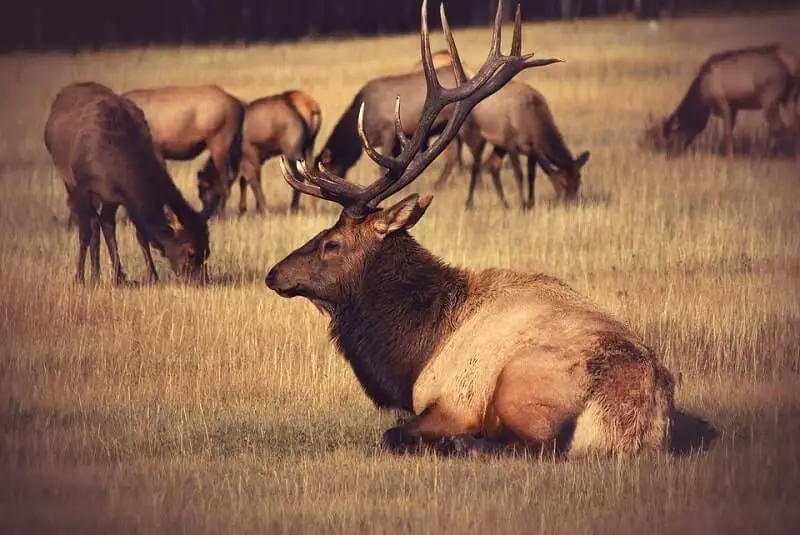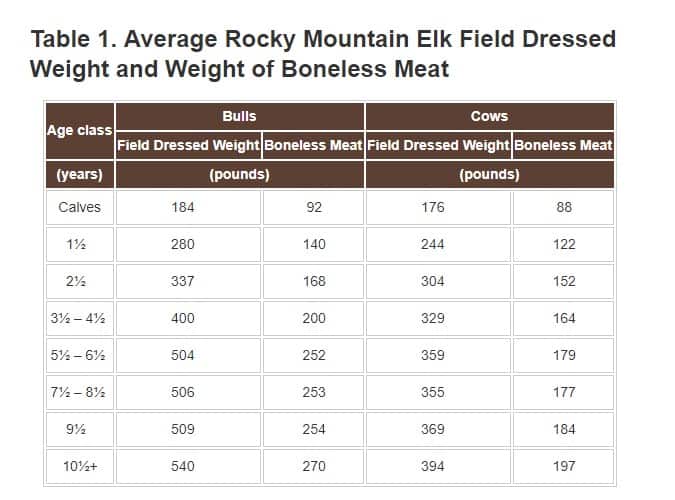
Are you one of us hunters who prefer large game or just like to challenge yourself every now and then? If so, then you should be familiar with elk hunting! Elks are among the largest game animals which are sought by both beginners and seasoned hunters alike because of their valuable meat, antlers, and hide.
However, when it comes to the amount of meat and transportation, we cannot help but wonder “how much does a bull elk weigh?”. Well, these massive beasts vary in size and weight depending on the specific subspecies, age, and other external factors.
So, if you want to find out what these weight ranges are and why it’s so important to know the weight of your game, you’ve come to the right place! Read on for more information!
Related Reading: The 5 Best Elk Hunting Backpack – [year] Pack Frames for Elk Hunting
What is a Bull Elk?
Elks, or sometimes called wapiti, are one of the largest land mammals belonging to the deer family or the Cervidae family. In fact, an elk is around 5-7 times the size and weight of other deer species, such as the whitetail deer.
There are several subspecies of elk which also differ in general size and weight. The largest subspecies is the Roosevelt elk often found in Washington, Canada, Oregon, and California.
The largest Roosevelt bull elk was discovered in Alaska with a weight that can reach up to 1,300 pounds (600 kilograms). Most Roosevelt bull elks do, however, weigh around 900 pounds. Roosevelt cow elks weigh about 573 to 625 pounds (300-544 kilograms).
Tule elk cows usually weigh around 300 pounds while Tule elk bulls weigh an average of 400 pounds.
The smallest elk subspecies, on the other hand, is the Tule elk generally found in California which weighs only 370 to 500 pounds (170-250 kilograms).
Factors affecting the Weight of an Elk
The weight of an elk depends on factors such as the region where they are found, the climate, environment, and their food source. Therefore, elks of the same subspecies living in two different places can differ greatly regarding size and weight. You should, however, get a pretty accurate estimate if you consider the following aspects that affect the weight of these animals:
Age or Maturity
Of course, younger elks are also way smaller than mature elks. A calf can weigh about 33-35 pounds. The rate at which they grow and their diet will also determine how much weight they can gain as they grow older.
Gender
Males and females also have varied weight ranges. A bull elk is a male, which is much larger and heavier than a female, called a cow. Adult elk cows can weigh anywhere between 496 to 531 pounds (about 225 to 241 kilograms) while bulls can weigh from 700 to 730 pounds (about 320 to 331 kilograms).
Antlers
Elks lose their antlers every year during spring. A bull’s antler, which the cow does not have, also adds about 40 pounds to its weight. Because of this, aside from the size, hunters use the presence of the antlers to identify a bull. Bulls are often more preferred because they provide more meat and the larger antlers are also valuable.
Read Article :
Why do you need to know how much a bull elk weighs?
You might be wondering why an elk’s weight is so important. Well, it is because a heavier game means more meat.
You’ll also need to get your kill out of the forest which can be a hassle since it isn’t possible to physically carry a 600 pound animal on your back. With a good weight estimation, you can invest in the right sized game carrier to help you get your animal out of rough terrains and closer to your truck.
Elk meat is considered a valuable type of meat because it is far richer in nutrients than any other meat such as chicken, pork, or beef. The meat also has a unique taste and scent. It’s also considered a lean-meat because game animals usually have less unhealthy fat compared to cattle or poultry meat.
Many hunters hunt elk for this reason and therefore want to know how much a bull elk will weigh once cleaned and deboned or in other words, how much meat they can get from it.
You should remember that you won’t get 600 pounds of meat from an elk that has a live weight of 600 pounds. Many parts of the elk like its antlers, head, skin, organs, and bones cannot be consumed. To get a more accurate estimate of the weight of meat you’ll be taking home, you should consider the following aspects.
Dressed or Undressed Weight
An elk’s field-dressed weight is also known as its carcass weight or dead weight. This is the weight of the animal after partially butchered to remove the internal organs, the head, and other undesirable portions such as the feet, legs, head, and tail. Internal organs are collectively called the viscera and are composed of almost all organs found in the abdomen such as the heart, lungs, and intestines.
Think of the dressed chickens you always find at your local grocery store. This is essentially the same thing, but this time applied to wild animals. To give you an idea of how an elk is hunted, field dressed, and quartered, check out this video.
On average, a dressed mature bull elk will lose 30% of its body weight than when it was living. So, its average field-dressed weight can go down to around 540 pounds while that of a smaller calf the average field-dressed weight could be about 176 pounds.
When you subtract this loss of weight from the original weight, you get a better idea of what the actual weight of the meat you take home will be.
The Bone Weight
Elks have a massive bone structure. The boneless meat yield is usually about half of a field dressed elk’s weight, regardless of whether it is male or female.
When deboned, the weight of an elk nosedives even farther. The average weight of the boneless meat from a whole elk can only be around 270 pounds for an adult bull and at least 90 pounds for an adult cow.
So, as hunters, we are not really concerned about the elk’s total weight, rather, we seek to know it so that we can approximate how much meat we can pack out on one kill. Aside from that, this information is very helpful in choosing a way to transport or pack out this large animal, especially today when horses are no longer used to haul dead prey.
How much does a bull elk weigh?
The following tables list down the general carcass weight guidelines of elks based on a study published by the University of Wyoming’s Agricultural Experiment Station.
In this study, around 25,000 elks were observed in different life stages, and information from 60,000 hunters was used. Therefore, they provide a pretty accurate representation of the general elk population.
There are many other links available, but I find these charts the most helpful. If you want to know the weight of an elk depending on its age, check out the first chart. The second chart, on the other hand, shows you how much different meat cuts and quartered portions will weigh.

Chart from: Backcountrychronicles.com
What is The Quartered Weight of Elks?
Hunters usually don’t debone their meat in the field, and many don’t debone their meat at all because the bones in meat give it texture and allow you to cook a wider range of meals. Just imagine a boneless T-bone steak for a moment, or consider what boneless ribs would look like. These meats would still be edible, but they won’t offer the same look or taste.
In most cases, the kill is field-dressed and divided into quarters so the meat can be stored in cooling facilities or transported with ease. If your quarters were to be deboned, they would weigh significantly less. Hind quarters are also much heavier compared to front quarters. Here’s a quick look at the typical weight of different sections of an average Rocky Mountain adult cow elk:
- Each hind quarter offers about 51 pounds of boneless meat and 6.5 pounds of hind quarters bone. That’s a field dressed weight of 57.5 pounds.
- Each shoulder offers about 34 pounds of meat and 4 pounds of bone. That’s a field-dressed weight of 38 pounds.
- The back straps weigh around 16 pounds.
- The rib, neck, and lean meat offers about 10 pounds of boneless meat.
These quarter measurements do, however, differ for different subspecies of elk and many conditions can affect the weight of your meat. Elks usually weigh significantly less during winter time or during droughts because there’s less to feed on.
Conclusion
So, how much does a bull elk weigh? Well, it’s complicated due to the many different factors at play. However, we do know that a bull elk can weigh much. Make sure to check out the guidelines and summarized charts in this article for future reference!
Did you learn something new? Did you enjoy this article? I hope you did! If so, do leave a comment below and please don’t forget to share it with other elk hunters!









